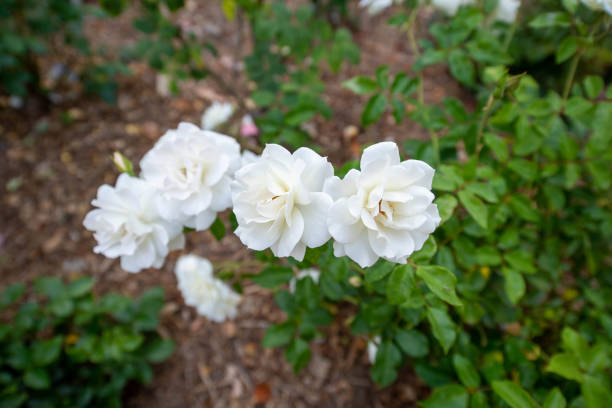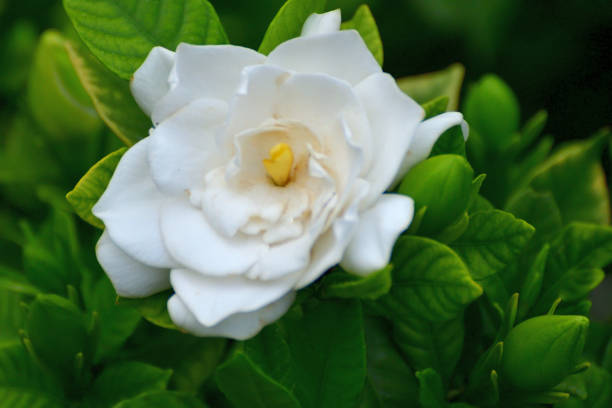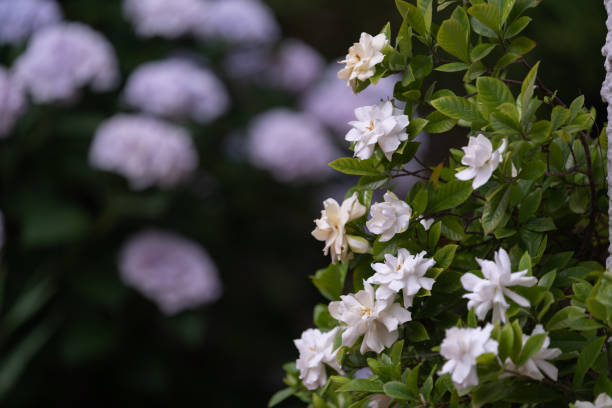What’s the Soil pH Level Requirement for Gardenia Plant?
Most people don’t think about the soil pH level required for a healthy gardenia plant, which is a mistake. Gardenia plants are sensitive to pH levels, so it is essential to know the soil pH level requirement for a healthy Gardenia plant. The pH of the soil will control several plant functions, including how much nitrogen and minerals are available to your plants. As we all know, acidic soil (with a pH of 5 or less) causes damage to the roots of plants and makes them vulnerable to disease. On the other hand, basic soil (with a pH above 7) could also be harmful if left untreated. The pH level requirement needed to keep a Gardenia plant healthy will depend on what species of plants you have. This article will help you determine what pH level is acceptable generally to all Gardenia varieties. It’s important to know the pH level requirement for different plants and when and how it’s best to add additional soil amendments.

Table of Contents
What Is the Ideal Soil Ph Level for a Gardenia?
The pH level suitable for growing any Gardenia variety can be stretched and compromised. The ideal range for your acid-loving Gardenia plant ranges exactly between 4.5 to 7 pH levels in general, depending on which type of plants you have planted and the variety that they are at the most optimal level. Gardenias can thrive in soil with extremely acidic levels. However, to be in the safe zone and cannot compromise, the best thing you can do is match nature’s perfect blend of elements with your own homegrown organic composted materials to get your plants growing at their peak. Nature has created the ideal soil to best provide everything plants, and gardeners need. A rich, loamy, well-drained soil is essential for all Gardenia cultivars. Drainage can be improved by adding peat moss or compost to the area where you currently have plants.
How to Make My Gardenia Soil Acidic?
Many Gardenia varieties will respond well to an acidic soil environment. When planting your seedlings, you can add a tablespoon of gypsum (calcium sulfate) three days before the young plants emerge from their pots to help acidify the soil and start them off on the correct path early in life. The addition of sulfur-rich organic inputs such as manure or worm castings is also highly beneficial for reducing pH levels naturally if available. As the plant ages, the pH level it requires can become less precise and consistent. The ideal outcome is a more balanced growth that allows your plants to flourish while they grow towards maturity in their best set during different seasons of life. Maintaining similar relative soil ph levels between successive years helps ensure large save yields regardless if you want Gardenias for either small bouquets or larger specimen stands.

How to Check Your Soil’s Ph Levels
The pH level of your soil can and does change over time. It is because of so many factors that can affect the soil pH. This is why it’s important to take a representative soil sample from your garden and do a pH test now and then. But before checking the pH level, you need to know how to properly collect soil samples.
How to Collect a Soil Sample
Things you need:
- a clean pail
- a gardening hand shovel
- a few sheets of paper
Directions:
- Dig 12-15 separate spots in your garden and collect tiny shovelfuls of soil from each, digging them to a depth of 6 to 10 inches and putting them in a bucket after you’ve finished. Avoid any areas that are significantly different from the rest of the area, such as water-collecting areas, sandy areas, and so on.
- Remove any pebbles, twigs, or other foreign debris from the soil.
- Disperse the moist dirt on a sheet of newspaper and let it air dry for at least one night. To dry it, do not place it in a microwave or oven.
Professional Soil Test
You can get a more precise reading of soil pH by having it tested by a commercial soil testing facility. If you have acidic soil, the test results are frequently followed by a recommendation to add lime to the soil, typically costing $7-10 per sample.
Soil samples need only be collected, allowed to air dry, and sent to the lab by the lab’s packaging instructions.
DIY Method Without a Kit
Thins you need:
- baking soda
- vinegar
- salt (to conduct a simple soil test to determine if your soil is acidic, neutral, or alkaline)
- A glass bowl
- a spoon
- purified water (Using water from the tap, bottled water, or rain will alter your results because these are all alkaline or acidic, respectively)
Directions:
- Add about a cup of soil to the bowl, then add enough distilled water to make mud.
- Gently whisk in 12 cups vinegar to the mud mixture. Your soil is alkaline if it bubbles or fizzes. If nothing happens, your soil is neutral or acidic.
- Make another batch of mud and add 12 cups of baking soda, mixing it a little. If it bubbles or fizzes, your soil is acidic, and you need to add more acid. The soil’s pH level stays the same if no changes happen.
pH Meters
A pH testing meter is the most reliable and precise way to check your soil pH. Although it is the most expensive one-time investment, the ph meter can last a long period if properly maintained.
Things you need:
- A glass container
- a spoon
- distilled water
- pH meter
Directions:
- Add equal amounts of dry soil and distilled water in a glass container.
- Allow the soil/water mixture to sit undisturbed for 15 minutes before moving on to the next step.
- Take a reading following the manufacturer’s instructions after stirring the dirt for another 5 to 10 seconds.
pH Testing Strips
You can buy pH test strips to get a more accurate measurement. Use them to test your soil. The strips are more reliable, but how well you read the litmus paper makes the results more or less reliable.
Things you need:
- a soil test kit from an online store
- a glass bowl
- a spoon
- distilled water
Directions:
- One cup of soil and enough room-temperature distilled water should be put in the bowl.
- Dip a test strip for 20-30 seconds in the mud mixture after removing it from the container and holding it by the non-reading end.
- Remove any soil residue from the test strip by quickly rinsing it in distilled water.
- Calculate the estimated pH by comparing the developed color on the test strip’s end to the color chart on the manufacturer’s packing.

How To Correct the Soil pH Level of the Soil
Limestone is typically employed to raise a solution’s pH level and sulfur to lower it. Dolomitic limestone comprises calcium carbonate and magnesium carbonate, whereas limestone is a comparatively pure calcium carbonate substance. Compared to pure limestone, dolomitic limestone neutralizes acidity and contributes more magnesium to the soil per pound of material.
Factors that Affect Soil pH
Rainfall Level
People who live in regions with a lot of rain are more likely to have acid soils. Rainwater is a little acidic because it reacts with carbon dioxide in the air to make carbonic acid. This makes the water a little acidic. When it moves through the soil, it removes cations and bicarbonates, making H+ more concentrated than other cations.
Arid regions are more likely to have soils rich in alkaline ions than humid ones. The cation and bicarbonate leaching from the soil profile does not occur in areas with less rainfall, resulting in a reduced concentration of hydrogen ions in the soil.
Parent Material
Acidic soils are generated when sandstone or shale is weathered away. Limestone is responsible for the formation of alkaline soils. During the long weathering process, parent minerals found deeper beneath the earth’s surface are transformed into soil. The rocks that emerge from the underground layers of bedrock vary from extremely acidic to extremely alkaline. The soil is generated as a result of their decomposition.
Irrigation Water Quality
Using irrigation water instead of natural rainfall results in alkaline soil, which is the opposite of when rainfall occurs naturally. Carbonate and bicarbonate forms of calcium and magnesium are common in irrigation water.
In arid soils (which may already have a higher pH than neutral), irrigation water reacts with dissolved bicarbonates, lowering their concentration and raising the pH even higher. Soil pH can be further boosted by calcium or magnesium carbonates that precipitate out of irrigation water.
Acid Rain
On the other hand, acid rain contains sulfuric and nitric acid as a result of fossil fuel combustion. As sulfuric and nitric acid reacts with soil bicarbonates to increase the concentration of H+ in acid rain-prone areas, the pH of the soil will decline.
Growth and Nutrient Uptake of Plants
Plants cannot survive without drawing nutrients from the earth and storing them in their roots. Cations (molecules with a positive charge) take up more space than ions. Roots release H+ ions back into the soil to maintain a neutral balance inside their cells. This acidifies the soil around the roots.
Fertilizer Applications
Fertilizers containing nitrogen are among the most common causes of soil pH changes. For plants to utilize nitrate (NO3-), ammonium fertilizers (NH4+) go through a process known as nitrification in the soil. Nitrification produces H+ ions, which raise the acidity of the soil.
